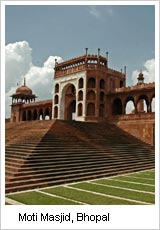Introduction:
The capital of Madhya Pradesh, Bhopal was built on the site
of the 11th century city of Bhojapal. It was founded by the
legendary Raja Bhoj who is credited with having constructed
the lakes around which the city is built. The present city
was laid out by the Afghan chief Dost Mohammed Khan, who was
in charge of Bhopal during Aurangzeb's reign, but took advantage
of the confusion following Aurangzeb's death in 1707 to carve
out his own small kingdom. Today, Bhopal has a multifaceted
profile. There's the old city with its crowded market places,
huge old mosques, and the palaces of the former begums who
ruled over the city from 1819 to 1926. To the north sprawl
the huge industrial suburbs and the slums which these developments
inevitably give rise to. The new city with its broad avenues,
sleek high-rise offices and leafy residential areas lies to
the west. In the centre of Bhopal are two lakes which, while
providing recreational facilities, are also the source of
its plagues of mosquitoes. The city is also famous as the
site of the world's worst industrial disaster. On the right
of 3 December 1984, 40 tonnes of deadly methyl icocyanate,
a toxic gas used in the manufacture of pesticides by Union
Carbide, a US-based multinational company, leaked out over
the city of Bhopal. Carried by the wind, this deadly gas soon
enveloped the sleeping city.
Sightseeing:
Jama Masjid:
Gold spikes crown the minarets of this beautiful mosque, built
in 1837 by Qudsia Begum . It is said that centuries earlier,
a queen of King Udayaditya Paramara (1059-80 AD, a grandson
of Raja Bhoja), founded a temple here known as sabha Mandala
in 1184 AD.
Taj-Ual-Masjid:
It is a huge pink mosque with two massive white domed minarets
and three white domes over the main building . Said to be
the largest mosque in the country, the building of this towering
edifice was begun by Shah Jehan Begum(1868-1901) but was incomplete
on her death . This great queen, Bhopal's eighth ruler, left
many monuments in the city . After her death, lack of funds
prevented the completion of the Masjid and construction was
resumed only in 1971.
Bharat Bhawan:
One of the most unique national institutes in India, Bharat
Bhawan is a centre for the verbal, performing and visual arts,
designed by the well-known architect Charles Correa and opened
in 1982. It is now regarded as one of the most important centres
in the country for the preservation of traditional folk art.As
well as the workshops and theatres here, there's the Roopankar,
the impressive art gallery that 'shows you what is sadly missing
from the folk art churned out for tourists', as one reader
put it. Bharat Bhawan is in the Shamla Hills and is open daily
except Monday from 2 to 8 pm.
Moti Masjid:
The Moti Masjid was built by Qudsia Begum's daughter, Sikander
Jahan Begum, in 1860. Similar in style to the Jama Masjid
in Delhi, it is a smaller mosque with two dark-red minarets
crowned by golden spikes.
Tribal Habitat:
An open air exhibition of tribal house types located on Shamla
Hills, the Tribal Habitat is a presentation of actual size
dwelling houses typical of contemporary tribal cultures in
various states of India. The surroundings have been reconstructed
to match some of the interesting environmental features of
tribal villages.
The Chowk:
In the heart of the old city, the Chowk is lined with old
mosques and havelis, reminders of a bygone, princely lifestyle.
The shops in its narrow alleyways are treasure troves of traditional
Bhopali crafts.
Shaukat Mahal and Sadar Manzil:
Situated in the heart of the walled city, it is an architectural
curiosity. Shaukat Mahal is an architectural curiosity, its
mixture of style, in Occidental idioms, setting it apart from
the predominantly Islamic architecture of the area. It was
designed by a Frenchman, said to be a descendant of an offshoot
of the Bourbon kings of France.
Upper and Lower Lakes:
The larger Upper Lake covers six sq km. The Upper Lake is
divided from the Lower by an over bridge and is large in area.
Madhya Pradesh Tourism's boat Clubs on the Upper Lake provided
facilities for exciting trips by sail, paddle motor boats.
The booking office is at the bottom of the driveway leading
to the Wind & Waves Restaurant.
Van Vihar Safari Park:
This 445 hectares park is more of a zoo than a safari park,
despite the promise of 'natural surroundings'. But if you
are in the north during the monsoon, when all the national
parks are closed, it's good to know you don't have to completely
miss out on tigers, lions and crocodiles. The park is open
every day except Tuesday from 7 to 11.30 am and 4 to 6 pm.
Lakshmi Narayan Temple & Birla Museum:
There are good views over the lakes to the old town from the
Lakshmi Narayan Temple, also known as the Birla Mandir. Beside
it on Arera Hill is an excellent museum, containing a small
but very selective collection of local sculptures dating mainly
from the Paramana period. The stone sculptures are mainly
of Vishnu, Siva and their respective consorts and incarnations.
There is also a small selection of terracotta exhibits from
Kausambi and a reconstruction of the Zoo Rock Shelter from
Bhimbetka.
Government Archaeological Museum:
A fine collection of sculptures are on display here, from
various parts of Madhya Pradesh. | |
 |

